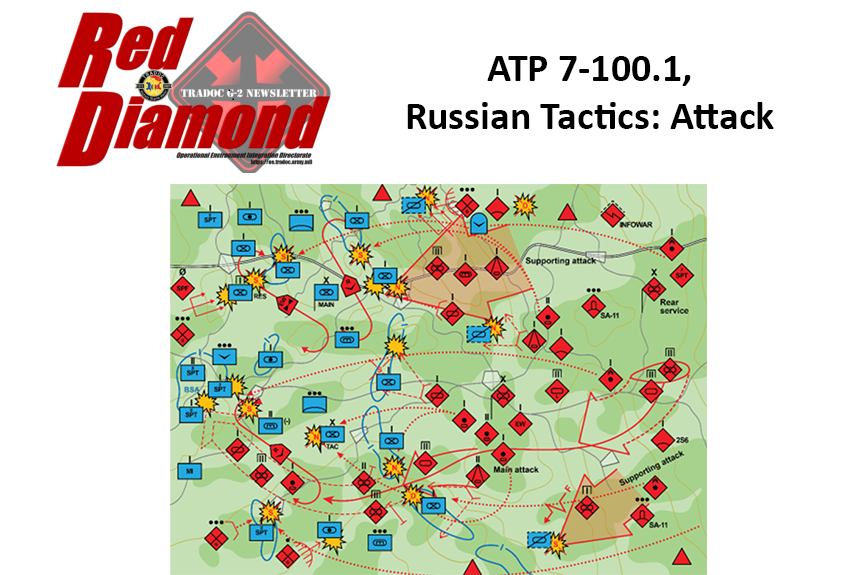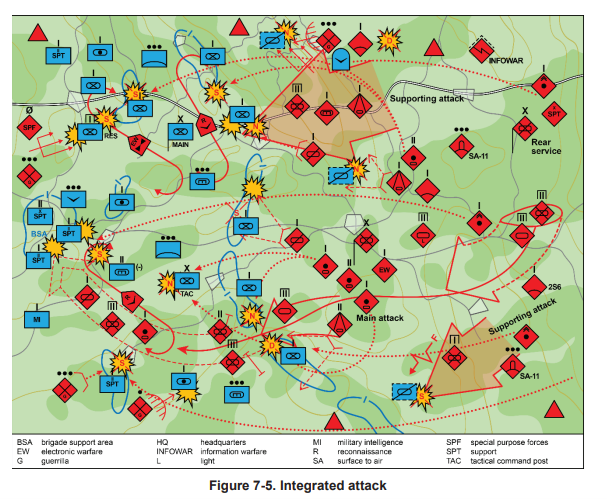
ATP 7-100.1, Russian Tactics: Attack
by Dorsel Boyer
This article is an excerpt from the recently published Army Techniques Publication 7-100.1 Russian Tactics. It distills critical concepts from the doctrinal publication into shorter, more digestible pieces. This edition will discuss the attack, an offensive action that destroys or defeats aggressor forces, seizes and secures terrain, or both.
This article is an excerpt from the recently published Army Techniques Publication (ATP), 7-100.1 Russian Tactics, and will distill critical concepts from the doctrinal publication into shorter, more digestible pieces. ATP 7-100.1 Russian Tactics is the U.S. Army doctrinal presentation of how Russian ground force doctrine indicates Russian ground forces will approach conflict. This article will explore Russia’s views of the strategic environment, with material drawn from Chapter 1: Russian Strategic Overview of ATP 7-100.1.1
Russia’s understanding of new generation warfare includes the concept of nonlinear, no-contact war where it is necessary to use all forces and effects to set the conditions for successful direct offensive engagement. This condition setting includes using proxy forces, rapid automation-supported decision making, precision targeting and fires for near real-time strikes, using simultaneous attacks throughout the depths of an aggressor’s formation, and battle management complexes that integrate all forces and effects. Use of these capabilities effectively results in a disorganized and disrupted aggressor force incapable of defending or counterattacking against an offensive action.
Integration of forces and effects at the strategic and operational levels create tactical opportunities for offensive action. Offensive actions continue to adhere to the historic principles of speed, mass, maneuver, and firepower. Integration is the key to delivering an offensive strike adhering to these principles. Tactical application has expanded to include not only ground maneuver units but also all forces and effects in all domains: land, maritime, air, information, and space domains. The aim of offensive action at the tactical level is to accomplish tactical missions in support of larger operations. A tactical command ensures that its subunits thoroughly understand both the overall goals of an operation and the specific purpose of a particular mission.
PRINCIPLES OF COMBINED ARMS: The Ground Forces combined arms units and subunits follow the principles of modern combined arms combat described in their doctrine. They are the fundamental building blocks that serve as the basis for the commander’s initiative and creativity and facilitate making the correct decision that accomplishes designated objective. The principles the Ground Forces follows are:
· Constant high combat readiness for the main combat subunits; BTGs.
· High activity.
· Determination and continuity of combat actions.
· Suddenness of action.
· Maintaining continuous engagement in combat.
· Resolutely concentrating all efforts on the main objective at the right time.
· Maneuvering forces, means, and fires.
· Counting on moral and psychological factors to accomplish mission tasks.
· Comprehensive integration of all combat actions. z Maintaining or rapidly restoring combat capability.
· Solid and continuous battle management.
· Intransigence in achieving the designated objectives.
· Full implementation of tasks assigned.
OFFENSIVE ORGANIZATION – DIVISIONS, REGIMENTS, AND BRIGADES: Division, regimental, or brigade commanders specify the initial required mission objectives of the units and subunits within their commands. Commanders plans task-organize resources to achieve integration of all forces and means at their disposal to accomplish the offensive mission. At the tactical level of unit or task-organized units, multiple mission tasks can be assigned to a division, regiment, or brigade based on the resources available, including those allocated from higher levels. The commander will adjust force allocations during an offensive mission to address emergent tactical conditions and reinforce successes.
In the offense, the first echelon is a combined arms force composed of one-half to two-thirds of the available combat power sufficient to find, fix, and destroy the first echelon aggressor units. The first echelon conducts the main attack to achieve the immediate mission objective set by the next higher level typically oriented on an aggressor unit.
The second echelon correspondingly has one-half to one-third of the available combat power with a specific mission objective as opposed to a reserve’s mission. The reserve executes emerging missions directed by the commander as the battle develops. The second echelon may reorient from the original attack plan to take advantage of the first echelon’s success in creating gaps or breaches in the aggressor defenses. The second echelon mission objective is usually oriented on penetrating an aggressor unit to strike into the depth and destroy C2, support, or reserves. Its mission remains the same even when taking the initiative to exploit success.

TACTICAL OFFENSIVE ACTIONS: The types of tactical offensive actions guide decision making on how to best achieve a mission during large-scale war. An offensive mission typically includes subordinate units executing specified offensive and defensive actions within an overall offensive mission framework. In the SV tactical combat formations, both units and subunits are typically deployed in two echelons in both the offense and defense. On the offense, the second echelon is expected to take advantage of the success of the first echelon and, by maintaining the offensive, attain the subsequent objective of the parent organization.
ATTACK: An attack is an offensive action that destroys or defeats aggressor forces, seizes and secures terrain, or both. It seeks to achieve a tactical objective through primarily military means by defeating the aggressor’s military power. This defeat does not necessarily result from the destruction of equipment but through the disruption, dislocation, and subsequent paralysis that occurs when combat forces are rendered irrelevant by the loss of the capability or will to continue the fight.
All attacks integrate offensive actions using combined arms to destroy the aggressor’s will and ability to continue armed conflict. An integrated attack is often conducted when Russian forces enjoy overmatch against an aggressor and focus significant aspects of combat power on an objective. It
can also be directed against a more sophisticated and capable opponent when a tactical opportunity emerges or is created during an operation.

Russian offensive doctrine places a premium on integrating fires, strike, and mass to overwhelm the defender. Russian commanders will use a broad spectrum of tactical and operational means to prepare the objective for an attack. Fires and strike capabilities will attempt to disrupt logistics and make prepared defenses untenable, while information operations will challenge mission command and morale. During the ongoing conflict in Ukraine, Russia has demonstrated flexibility in the composition and disposition of assault troops (transitioning from the Battalion Tactical Group to Assault Detachment) while adhering to the principles described in their base doctrine.2
Notes
1 ATP 7-100.1 Russian Tactics. (2024) 2024. C.1 ed. Fort Leavenworth, KS: United States Army.
https://armypubs.army.mil/epubs/DR_pubs/DR_a/ARN40737-ATP_7-100.1-001-WEB-4.pdf
2 Battersby, Blair, and Dorsel Boyer. 2023. “Russian Assault Groups’ Evolution in Ukraine.” Red Diamond, December.
https://oe.tradoc.army.mil/2023/12/15/tradoc-russian-assault-groups-evolution-in-ukraine/
Distribution A: Approved for public release
Categories:
Tags:
ATP 7-100.1, Russian Tactics: Attack
by Dorsel Boyer
File Size:
787KB
File Type:
Page Count:
5

